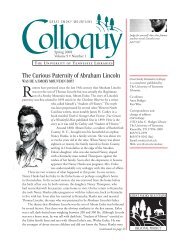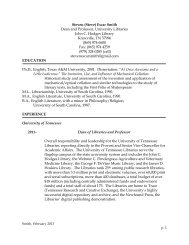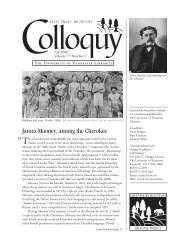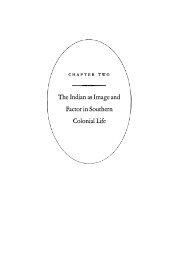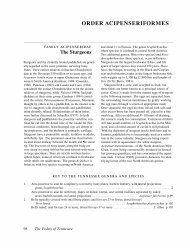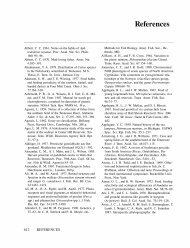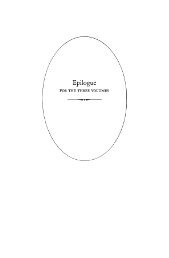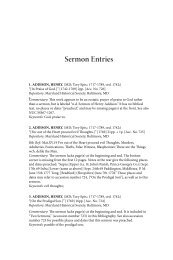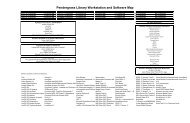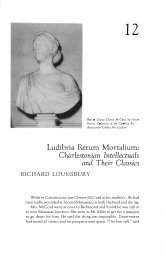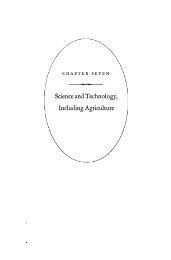Literature, Principally Belletristic - University of Tennessee, Knoxville
Literature, Principally Belletristic - University of Tennessee, Knoxville
Literature, Principally Belletristic - University of Tennessee, Knoxville
Create successful ePaper yourself
Turn your PDF publications into a flip-book with our unique Google optimized e-Paper software.
· INTELLECTUAL LIFE IN THE COLONIAL SOUTH '<br />
Now rumbling in the dark aerial Hall,<br />
Till scattering far away<br />
The horrid Murmurings decay,<br />
And die away and fall.<br />
These lines are from a 1751 "A Description <strong>of</strong> a Storm" published in the<br />
Virginia Gazette (July 4, 1751) as well as in Miscellaneous Poems. His<br />
later lines on "The War <strong>of</strong> the Elements" jotted in his diary depict an even<br />
more stupendous Nature <strong>of</strong> lightning flashes and thick gloom and horrors<br />
<strong>of</strong> the dark, "the Wreck <strong>of</strong> Worlds . .. / the blended Roar <strong>of</strong> Thunder,<br />
Winds and Waves / In ,Tumult," with a new image as each tremendous<br />
wave struck his ship.249<br />
His hymns were usually composed, like so many <strong>of</strong> Edward Taylor's<br />
poems, to accompany sermons, especially those homilies preparing Davies'<br />
flock for the Sacrament <strong>of</strong> the Lord's Supper. That they were effective is<br />
borne out by the fact that they were printed by several religious denominations<br />
as "Communion Hymns" down to the end <strong>of</strong> the last century. These<br />
and his other meditative verse were written in a southern colony touched<br />
by the Great Awakening by a deeply devout and artistically gifted man<br />
who was also learned. His one volume <strong>of</strong> verse, his pamphlet sermons<br />
with hymns attached, were bought, and read, by stout Anglicans as well as<br />
Presbyterians, as the Virginia Gazette bookstore account books and the<br />
copies in many libraries testify, and the poems were copied in newspapers<br />
and early magazines from South Carolina to New Hampshire. Several<br />
were printed in British magazines, some with versions <strong>of</strong> his individual<br />
sermons. The controversy as to the artistic merits <strong>of</strong> the completed poems<br />
carried on in the Virginia Gazette indicates the local interest in the man<br />
and his work.<br />
One may never call his verse great poetry and by no means all <strong>of</strong> it good<br />
poetry, but it was the rhymed representation <strong>of</strong> a significant American<br />
movement, the Great Awakening. And with all due allowance for the Bay<br />
Psalm Book and Michael Wigglesworth and a number <strong>of</strong> New England<br />
fugitive religious poets, it was Samuel Davies who brought the muse <strong>of</strong><br />
sacred poetry before the American public.<br />
One might say John Wesley's 1737 Charleston volume was Davies'<br />
precursor and some scattered individual religious verses his southern colonial<br />
successors. The blacksmith-lay reader Anglican poet Charles Hansford<br />
(1685-1761), the Anglican schoolmaster-parson Goronwy Owen<br />
(1723-1769) who wrote largely in his native Welsh even in Virginia,<br />
and the Scottish (possibly Presbyterian) James Reid (fl. 1768-1769) all<br />
composed verses which might be designated as religious in theme.<br />
Owen, who held the mastership <strong>of</strong> the grammar school at William and<br />
Mary and a parish in rural Virginia, was a most significant Welsh bard



